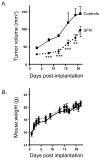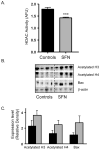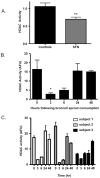Sulforaphane retards the growth of human PC-3 xenografts and inhibits HDAC activity in human subjects
- PMID: 17259330
- PMCID: PMC2267876
Sulforaphane retards the growth of human PC-3 xenografts and inhibits HDAC activity in human subjects
Abstract
Sulforaphane (SFN) is an isothiocyanate found in cruciferous vegetables such as broccoli. This anticarcinogen was first identified as a potent inducer of Phase 2 enzymes, but evidence is mounting that SFN acts through other cancer chemopreventive mechanisms. We recently reported on a novel mechanism of chemoprotection by SFN in human colon cancer cells and prostate epithelial cells, namely the inhibition of histone deacetylase (HDAC). In the present investigation, we sought to test whether SFN also might inhibit HDAC activity in vivo. When consumed in the diet at an average daily dose of 7.5 mumol per animal for 21 days, SFN suppressed the growth of human PC-3 prostate cancer cells by 40% in male nude mice. There was a significant decrease in HDAC activity in the xenografts, as well as in the prostates and mononuclear blood cells (MBC), of mice treated with SFN, compared to controls. There also was a trend towards increased global histone acetylation in the xenografts, prostates, and MBC. In human subjects, a single dose of 68 g BroccoSprouts inhibited HDAC activity significantly in peripheral blood mononuclear cells (PBMC) 3 and 6 hrs following consumption. These findings provide evidence that one mechanism through which SFN acts as a cancer chemopreventive agent in vivo is through the inhibition of HDAC activity. Moreover, the data suggest that HDAC activity in PBMC may be used as a biomarker for assessing exposure to novel dietary HDAC inhibitors in human subjects.
Figures




Similar articles
-
Dietary histone deacetylase inhibitors: from cells to mice to man.Semin Cancer Biol. 2007 Oct;17(5):363-9. doi: 10.1016/j.semcancer.2007.04.001. Epub 2007 May 5. Semin Cancer Biol. 2007. PMID: 17555985 Free PMC article. Review.
-
A novel mechanism of chemoprotection by sulforaphane: inhibition of histone deacetylase.Cancer Res. 2004 Aug 15;64(16):5767-74. doi: 10.1158/0008-5472.CAN-04-1326. Cancer Res. 2004. PMID: 15313918
-
Sulforaphane inhibits histone deacetylase in vivo and suppresses tumorigenesis in Apc-minus mice.FASEB J. 2006 Mar;20(3):506-8. doi: 10.1096/fj.05-4785fje. Epub 2006 Jan 11. FASEB J. 2006. PMID: 16407454 Free PMC article.
-
Differential effects of sulforaphane on histone deacetylases, cell cycle arrest and apoptosis in normal prostate cells versus hyperplastic and cancerous prostate cells.Mol Nutr Food Res. 2011 Jul;55(7):999-1009. doi: 10.1002/mnfr.201000547. Epub 2011 Mar 4. Mol Nutr Food Res. 2011. PMID: 21374800 Free PMC article.
-
Modulation of histone deacetylase activity by dietary isothiocyanates and allyl sulfides: studies with sulforaphane and garlic organosulfur compounds.Environ Mol Mutagen. 2009 Apr;50(3):213-21. doi: 10.1002/em.20454. Environ Mol Mutagen. 2009. PMID: 19197985 Free PMC article. Review.
Cited by
-
The influence of sulforaphane on vascular health and its relevance to nutritional approaches to prevent cardiovascular disease.EPMA J. 2011 Mar;2(1):9-14. doi: 10.1007/s13167-011-0064-3. Epub 2011 Feb 12. EPMA J. 2011. PMID: 23199123 Free PMC article.
-
Current Landscape of NRF2 Biomarkers in Clinical Trials.Antioxidants (Basel). 2020 Aug 7;9(8):716. doi: 10.3390/antiox9080716. Antioxidants (Basel). 2020. PMID: 32784785 Free PMC article. Review.
-
Sulforaphane regulates self-renewal of pancreatic cancer stem cells through the modulation of Sonic hedgehog-GLI pathway.Mol Cell Biochem. 2013 Jan;373(1-2):217-27. doi: 10.1007/s11010-012-1493-6. Epub 2012 Nov 6. Mol Cell Biochem. 2013. PMID: 23129257
-
Sulforaphane epigenetically regulates innate immune responses of porcine monocyte-derived dendritic cells induced with lipopolysaccharide.PLoS One. 2015 Mar 20;10(3):e0121574. doi: 10.1371/journal.pone.0121574. eCollection 2015. PLoS One. 2015. PMID: 25793534 Free PMC article.
-
Prolonged sulforaphane treatment does not enhance tumorigenesis in oncogenic K-ras and xenograft mouse models of lung cancer.J Carcinog. 2012;11:8. doi: 10.4103/1477-3163.98459. Epub 2012 Jul 13. J Carcinog. 2012. PMID: 22919281 Free PMC article.
References
-
- Myzak MC, Dashwood RH. Histone deacetylases as targets for dietary cancer preventive agents: lessons learned with butyrate, diallyl disulfide, and sulforaphane. Curr Drug Targets. 2006;7:443–452. - PubMed
-
- Johnstone RW. Histone-deacetylase inhibitors: novel drugs for the treatment of cancer. Nat Rev Drug Discov. 2002;1:287–299. - PubMed
-
- Marks P, Rifkind RA, Richon VM, Breslow R, Miller T, Kelly WK. Histone deacetylases and cancer: causes and therapies. Nat Rev Cancer. 2001;1:194–202. - PubMed
-
- Marks PA, Richon VM, Rifkind RA. Histone deacetylase inhibitors: inducers of differentiation or apoptosis of transformed cells. J Natl Cancer Inst. 2000;92:1210–1216. - PubMed
Publication types
MeSH terms
Substances
Grants and funding
LinkOut - more resources
Full Text Sources
Medical
Research Materials
Miscellaneous
